Summary
- World Wide Web Consortium
- The Semantic Web
- Motivation
- Standards
- Applications
- Possibilities
W3C's Mission: Leading the Web to its Full Potential
Founded by Web inventor Tim Berners-Lee in
1994:
- Providing the Vision to Lead.
- Engineering the Standards that Make the Web Work.
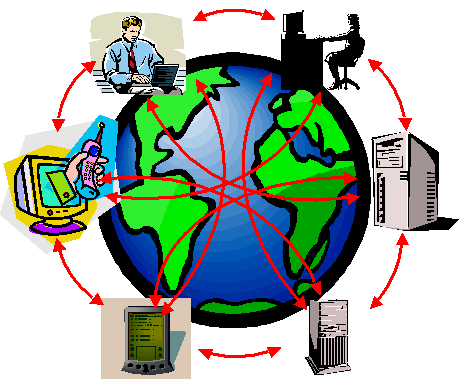 |
- From a Web of Documents ...
- ... toward a Web of data and programs that is:
- Meaning-ful
- on Everything
- for Everyone
- ... and Interoperable, Safe, Evolvable
|
(Flyer: US, A4
/ History)
Web of Meaning
People and communities have data stores and applications to
share
- Vision
- Expand the Web to include more machine-understandable resources
- Enable global interoperability between resources you
know should interoperaperable as well as those you
don't yet know should be interoperable
Key Web technologies:
- Web Services: Web of Programs
- Standards for interactions between programs, linked on the Web
- Easier to Expose and Use services (and data they
provide)
- Semantic Web: Web of Data
- Standards for things, relationships and descriptions, linked on the
Web
- Easier to Understand, Search for, Share,
Re-Use, Aggregate, Extend information
What Dogs Understand
Analogy:
What We Say to Dogs
- cartoon ...
- "Stay out of the garbage! Understand, Ginger? Stay out of the
garbage!"
What Dogs Understand
- "... blah blah blah blah GINGER blah blah blah
blah ..."
What Computers Understand on Current Web
 |
" ... blah blah
blah <a
href=http://www.xwz.com/foo.html> link</a>
blah blah blah . . . ."* |
- Computers must "understand" more:
- Not human concept of "understanding"
- Just useful machine processing
Toward Processable Search Semantics
Google:
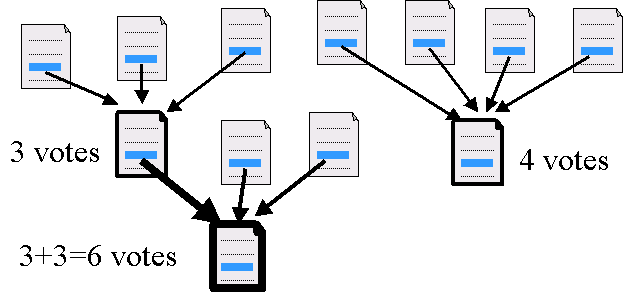
- Web links are machine processable
- Minimal semantics assumed: "This" refers to "that" = popularity
- Amazing results from minimal semantics
What if Web pages had more machine processable semantics?
(See Article by Bijan Parsia)
Ways to Enable Machine Processing
Smarter Machines
- Teach computers to infer the meaning of Web content
- Natural language, image recognition, etc.
- ... this is the Artificial Intelligence approach
- WARNING: Hard problem!
- This is not what the Semantic Web
is about
Smarter Data
- Make content easier for machines to find, access and process
- Express data and meaning in standard machine-readable format
- Support decentralized definition and management
- ... this is what the Semantic Web
is about
Semantic Web Standards
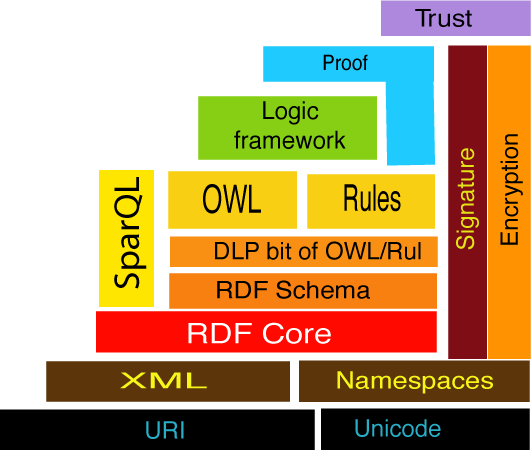 |
Machine-processable, global Web standards:
- Assigning unambiguous names (URI)
- Expressing data, including metadata (RDF)
- Capturing ontologies (OWL)
- Query, rules, logic, proofs, trust (in progress)
Accessible wherever you want it to be ...
... on the Web.
|
Uniform Resource Identifiers (URI)
- URIs have two
different uses:
- Unambiguous name for something
- Location of a document
- URIs can be used to identify definitions for concepts
- Especially useful for ontologies & metadata
Resource Description Framework (RDF)
- W3C standard (Primer)
- XML syntax
- Statements about things (concepts, objects, etc.)
- Metadata, plus more
- Descriptive statements expressed as triples:
(Subject, Predicate, Object) or (Subject, Property,
Value)

- Most useful, Web-wise, when these are URIs, e.g. for this presentation:
RDF: Flexible Representation
Linking table and tree data ...
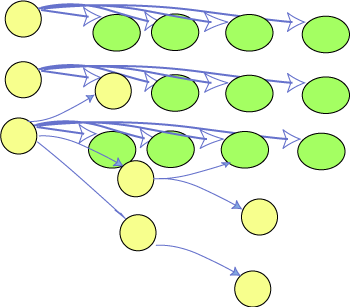
Web Ontology Language (OWL) +
- W3C standard (Guide, Overview)
- Defining concepts & relationships within area of knowledge
- Like DBMS data dictionary or schema, but ..
- Global, standard syntax based on RDF
- Can define more complex relationships
- Using URIs as keys
- On the Web
- Includes standard vocabulary for describing properties and classes.:
- Datatypes (e.g., integer, date, string ..)
- Relations (e.g. subclass of, property of ..)
- Cardinality (e.g. exactly one ..)
- Characteristics of properties (e.g. symmetry)
- ... and more
Standards En Route
- Logic, proof, trust, etc.
Current Web
- Minimal machine-processable information -- dumb links
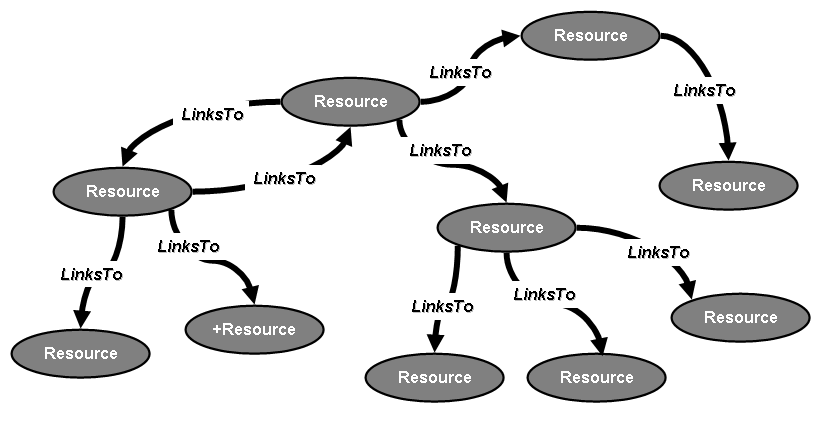
Semantic Web - Enhancement of Current Web
- More machine-processable information - applications connected by
concepts

___
[ellipses = resources; ellipse/line
color = one data source; x: = one ontology]
Semantic Web Applications
- Pioneer domains
- Enterprise integration
- Data management
- Life sciences
- Personal and consumer information
- Growing Industry Update
- Vodafone, IBM, Oracle, Adobe, Nokia, HP, Fujitsu, NEC, many
others
Enterprise Integration Today
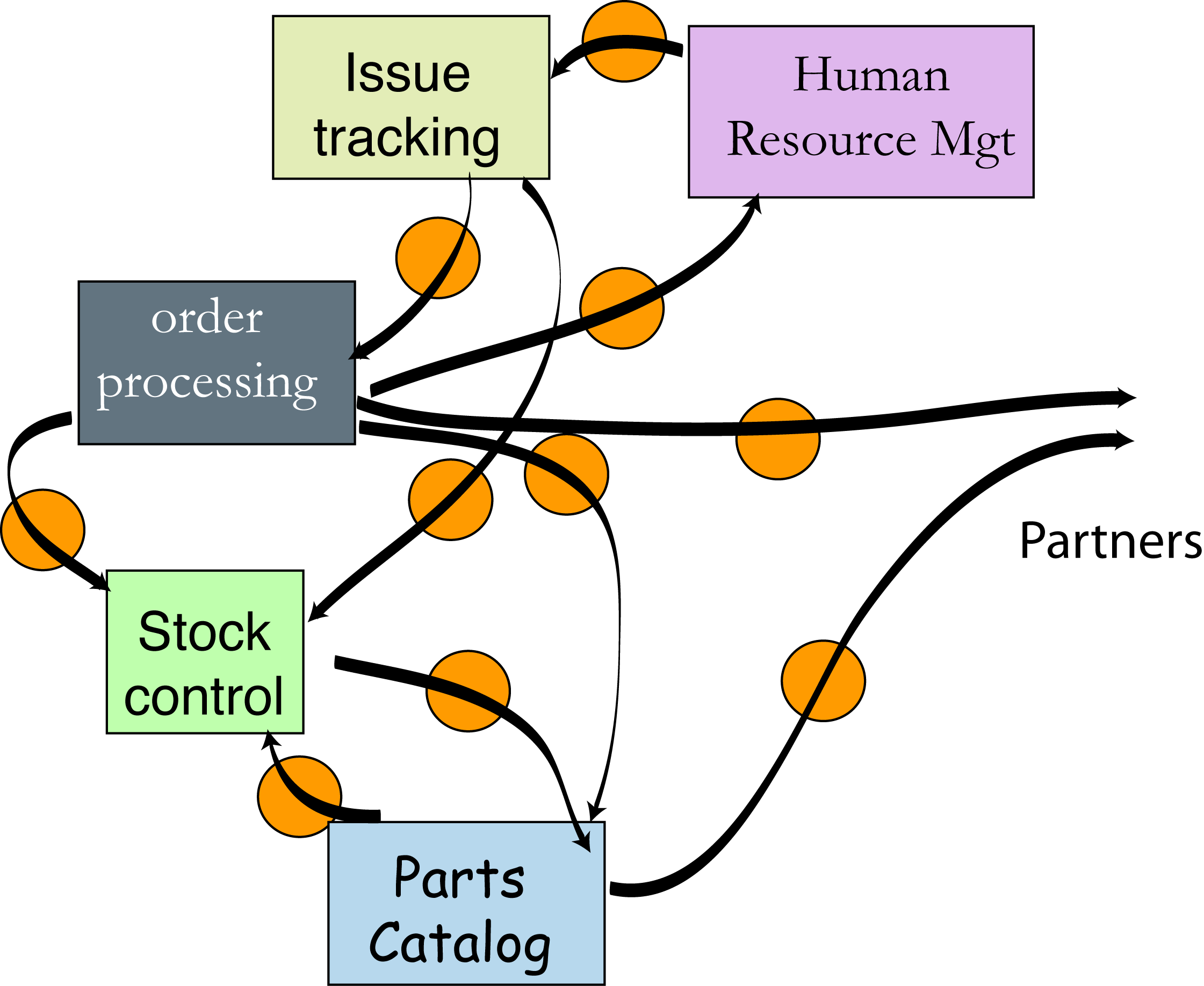
Enterprise Integration on the "RDF Bus"
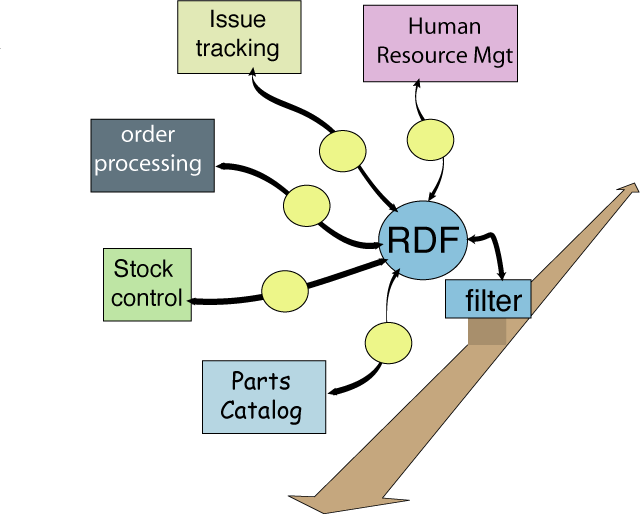
Clients on the "RDF Bus"
New data applications can be built on top of RDF bus, for example:
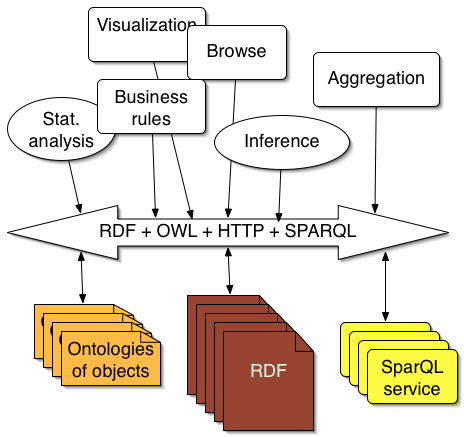
Applications Connected by Concepts
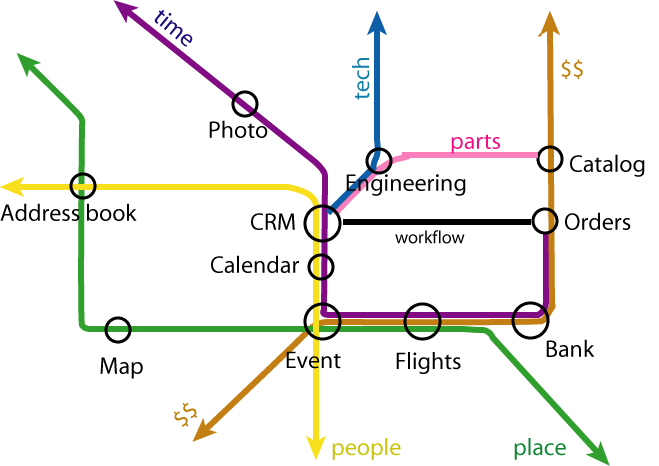
Real World: Vodafone
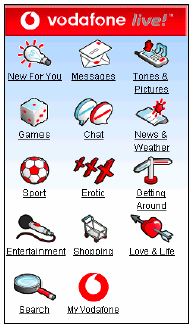 |
- Vodafone Live Mobile Portal
- RDF-based integration of products
- simple descriptive metadata scheme
- easy integration of multiple, diverse vendors
- flexible maintenance and extension
- Search results (e.g. ringtones, games, pictures, etc.)
- improvement: page views per download decreased 50%
- increased revenue: for ringtones, up 20% in 2 months*
- Ringtones market will surpass $500
million in retail sales in 2005!
|
Real World: IBM
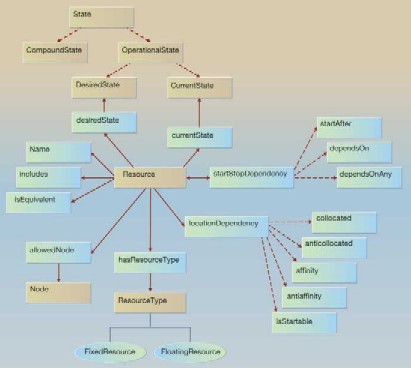 |
- Multiple effort in
Semantics
- Developing user-centered tools
- Exploit power of Semantic Web technologies, but hide the
underlying complexity
- Extraction, storage, query, editing, annotation,
visualization
- Focus on Life
Sciences - Potential for transforming the scientific research
process
- Common representation (RDF), unique identifiers (LSID),
provenance, collaboration
|
Real World: Oracle
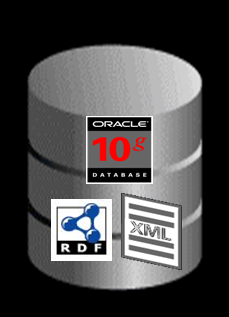 |
- Oracle
10.2 will include an RDF data model to store RDF
statements
- Java Ntriple2NDM converter for loading existing RDF data
- An RDF_MATCH function which can be used in SQL to find graph
patterns in RDF (similar to SPARQL)
- Interest in supporting life
sciences, and other, requirements
|
... from S. Stephens, Oracle, June
2005
Challenges Ahead
- Providing information in Semantic-Web-friendly ways
- Exposing existing data stores as RDF
- Automated and human-assisted tools to create RDF stores,
ontologies, mappings
- "Chicken and egg problem" en route to "network effect"
- Addressing operational and social needs
- "Worldwide" Web
- Quality, provenance, versioning, explanation, safety
- Privacy, access control, authorization
- Trust
- Making data accessible to people and programs
- Usable interfaces to masses of semantic data
- Search, filtering, aggregation, processing, graphics
- Access via multiple modes, multiple devices
Bottom-Up Evolution for SemWeb Global Data Interoperability
- Explore existing tools (see extra slides)
- Pick a few community applications and databases
- Develop key community ontologies
- Develop shared ontologies (broadly used, linking)
- Exponential grass-roots growth?
- More machine accessible data
- Directed and serendipitous discovery
- Better tools
- Killer apps
- Network effects
Thank You
We are happy to help ...

_
Acknowledgements: Tim Berners-Lee, David
Booth, Eric Miller
Resource slides follow (W3C, Web
Services and Semantic Web tools and applications)
International Web Standards Organization
W3C's expanding international basis of
operations (map)
W3C's Members Power Our Work
~ 370 Members (png, map history)
- World's leading technology organizations
- "Third-class companies make products; second-class companies
develop technology; first-class companies set standards." -
saying in China
- Commercial, academic, research institutions, government agencies,
non-profits
- Developing Web products, leveraging the Web, for your work, conducting
Web research, developing specifications built upon W3C's work
Values of W3C Membership
- Leadership
- Introduce ideas through submissions & workshops
- Influence standards through Working Group participation, review,
implementation
- Provide strategic direction through seat on Advisory Committee
- Early insight into market trends
- Access Member & Team technical experts
- Track emerging technologies & markets through
Member-confidential access
- Implement standards & plan for procurement of new technologies
ahead of market
- Promoting image as innovator
- Participate in international media activities, press releases,
testimonials
- Display organization and logo on W3C site (250K visits/day)
- Display W3C Member logo on organization's page
- Ensure & enjoy benefits of royalty-free implementation of Web
standards
W3C Brings the World Together to Engineer the Web
- Accountable to the Global Public
- Public lists, some public Interest Groups
- Groups must address all submitted issues
Developing Standards at W3C
- Clear and effective Process, which encourages:
- Member-neutrality
- Consistent architecture
- Coordination, consensus and
interoperability
- No "rubber stamping"
- Must engineer dependencies (inside and outside of W3C)
Views of the Process: Life of
Working Group, Recommendation Track
Some Web Services and Semantic Web References
Standards, specifications, profiles:
Integration of Web Services and Semantic Web
Semantic Web Research and Development Groups
Some Web Services Tools
* Most products not yet using new W3C standard versions of SOAP (1.2),
WSDL (2.0), etc., but they will in the future.
Some Semantic Web Tools
RDF Environments (interpreters, etc)
- Jena (from HP;
for Java, includes OWL reasoning)
- RDFLib (for Python)
- Redland
(in C, with interfaces to Tcl, Java, PHP, Perl, …)
- Sesame (RDF Schema based repository and querying
facility)
- cwm (general-purpose data processor for the semantic
web)
- Protege
(ontology editor)
- Access to Relational Databases (white paper)
- Annotea
(annotation of Web documents)
- Longwell (browse and search RDF datasets)
- Semantics tools (from IBM; for storage, manipulation,
query, and inference of ontologies)
SemWeb Graphical Editors
Some Web Service & Semantic Web Applications
Rapid growth of both ...
- Compilations of Web Service apps:
- Compilations of Semantic Web apps:
Challenge of Global Data Interoperability
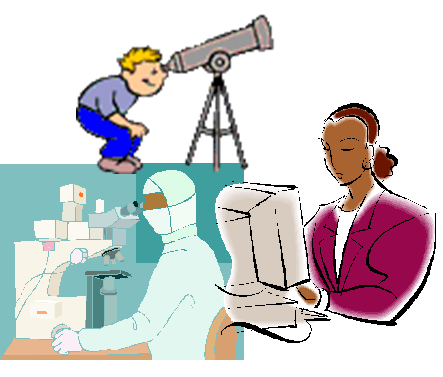 |
- Increasingly specialized communities...
- ... yet, important problems require multi-disciplinary and
multi-organizational approach
- Massive quantities of data ...
- ... yet, not readily understandable nor accessible outside
of community
- Already using the Web ...
- ... yet, mainly as a Web of documents, not as a Web of
machine-processable data
|
Today's Web: Searching
Current Situation:
- Search Web for information on "Love waves"
Issue:
- Some useful, some not-so-useful hits:
- "Love Wave Research at Brown"
- "Courtney Love Waves the Red Flag"
- " 'Buy Faith, Hope Love: Waves and Reflections', at Amazon and
SAVE"
- etc. ...
Today's Web : Sharing and Aggregating
Current Situation: Earthquake Monitoring:
- Web site A, B, C ...: fault, earthquake and other geo information
- Programs G, H, I ... : mapping, propagation, site response ...
- Email communications with X, Y, Z ... : gov't emergency authorities
- Want to aggregate data to (for R&D or realtime alerts):
- compare network locations and compute new ones
- examine correlations of geophysical observations
- interface with authorities re: events and risks
Issues:
- Different databases, attributes, locations, services
- Different jargon, meanings
- Not easy to find, access, process resources
- Must build specialized systems to important, convert, update ..
What Is the Semantic Web?
"The Semantic Web is an
... extension of the current web in
which
... information is
given
well-definedmeaning,
... better enabling computers and people to work in
cooperation."
___
The Semantic Web
Tim Berners-Lee, James Hendler and Ora Lassila
Scientific American, May 2001


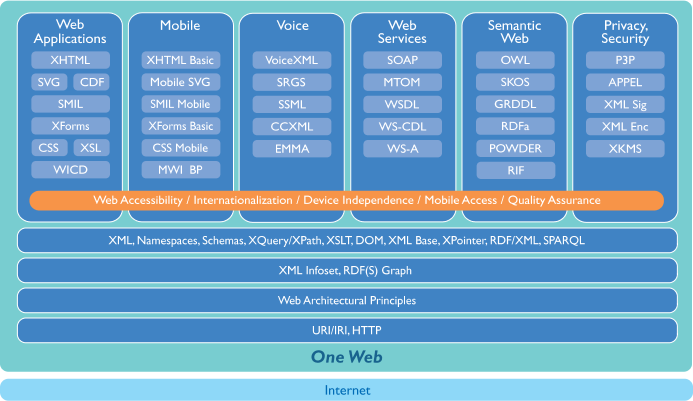









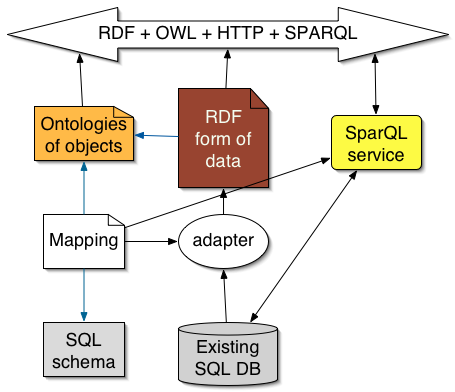




![]()

